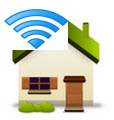Satellite internet speeds depend on which provider you choose. With HughesNet plans, everything is 25 Mbps. The only thing that changes from plan to plan is your data cap. With Viasat, speeds range from 12 Mbps on the basic plans up to 100 Mbps on the top-tier packages.
These speeds are fast enough for most everyday uses and even HD video streaming, but they come with two caveats: latency and data caps.
Satellite internet suffers from higher latency than other types of connections, like cable or fiber, because it has a longer distance to travel (all the way from space). This shows up for you as a slight delay between performing an action and seeing the result.
This usually isn’t super noticeable, but one area that it can be an issue is with online gaming, where the delay between action and result can be the difference between victory and defeat, especially in fast-paced competitive games like Call of Duty and Overwatch.
Data caps with satellite internet plans are a lot lower than with cable plans. And depending on your plan, you could experience serious slowing on your speeds once you hit your cap for the month.






0